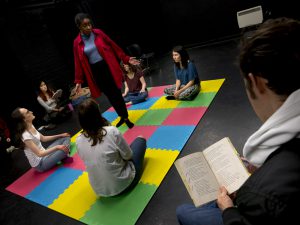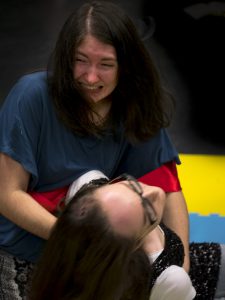
November 14, 2017, by Helen Lovatt
Medea at the New Theatre
Lynn Fotheringham previews an on-campus Greek tragedy production
The New Theatre production of Medea that I mentioned in my last blog-post opens tomorrow. I’ve been lucky enough to get to attend some of the rehearsals over the last fortnight, and to see the performance start coming together. Jazmine Greenaway probably has the most challenging job as Medea, with a huge part to learn: she’s on stage for most of the play and even has to act from the wings from time to time.
William Tillett, who plays Jason, is almost the only man involved in the production, which underlines some of the feminist readings of the play – the only other male name in the credits is the sound designer! Two and half years ago, I wrote about the fact that the number of female roles in Euripides’ Women of Troy proved to be an advantage for the production, because the New Theatre has so many female members. This production of Medea is also supplying opportunities for women students interested in theatrical work, both on-stage and off.
 The rest of the characters, both male and female – and including the Chorus – are played by four actors: Ellie Roberts, Megan Openshaw, Hannah Yates and Ellen Dennis. The playing both of multiple roles and across genders are of course true to the practice of ancient Greek tragedy productions themselves, in which there were only three actors at the most – in addition to the Chorus – and all the participants were men. The actors wore masks, which along with the costumes clearly differentiated the characters being played. An actor would go off stage wearing one mask and costume, and come back with new ones.
The rest of the characters, both male and female – and including the Chorus – are played by four actors: Ellie Roberts, Megan Openshaw, Hannah Yates and Ellen Dennis. The playing both of multiple roles and across genders are of course true to the practice of ancient Greek tragedy productions themselves, in which there were only three actors at the most – in addition to the Chorus – and all the participants were men. The actors wore masks, which along with the costumes clearly differentiated the characters being played. An actor would go off stage wearing one mask and costume, and come back with new ones.
Mask-work is difficult for modern actors and potentially alienating for the audience, and most modern productions don’t attempt it. As in many such productions, in this Medea the actors simply step out of the Chorus in order to play the individual characters, then merge back into the collective at the end of the scene. Without the chance to go completely off stage and undertake a major costume-change, they have to rely on small additions in the way of of costume and props – a coat, a crown, a walking-stick, for example – to indicate that the actor is now playing a different character. And of course on the movement and vocal talents of the actors, who can alter the way they stand and speak in order to indicate a change in age or gender.
 These ensemble actors have a challenging job too, then – and that’s before you take into account the choral interludes: the unison speaking, the recounting of mythological parallels and so on, that can be difficult for a modern audience to follow. From what I’ve seen, they’re more than up for the challenge, and director Emma Fearon has come up with a simple, elegant staging that uses movement and alternating voices to create both visual and aural variety, without getting too complicated. It’s a really impressive small production, and I’m looking forward to seeing it in its full glory on stage at the end of the week.
These ensemble actors have a challenging job too, then – and that’s before you take into account the choral interludes: the unison speaking, the recounting of mythological parallels and so on, that can be difficult for a modern audience to follow. From what I’ve seen, they’re more than up for the challenge, and director Emma Fearon has come up with a simple, elegant staging that uses movement and alternating voices to create both visual and aural variety, without getting too complicated. It’s a really impressive small production, and I’m looking forward to seeing it in its full glory on stage at the end of the week.
At time of writing seats could still be reserved for Friday evening and Saturday afternoon – but they’re looking into fitting more seats on stage to see if they can increase capacity. Extra availability will be announced on the New Theatre Facebook page – and it can also be worth turning up at the theatre (building 12 on this map) in case there are unclaimed seats just before the performance.
Picture credits:
poster supplied by the New Theatre
rehearsal photographs (c) Matt Brooker
No comments yet, fill out a comment to be the first

Leave a Reply